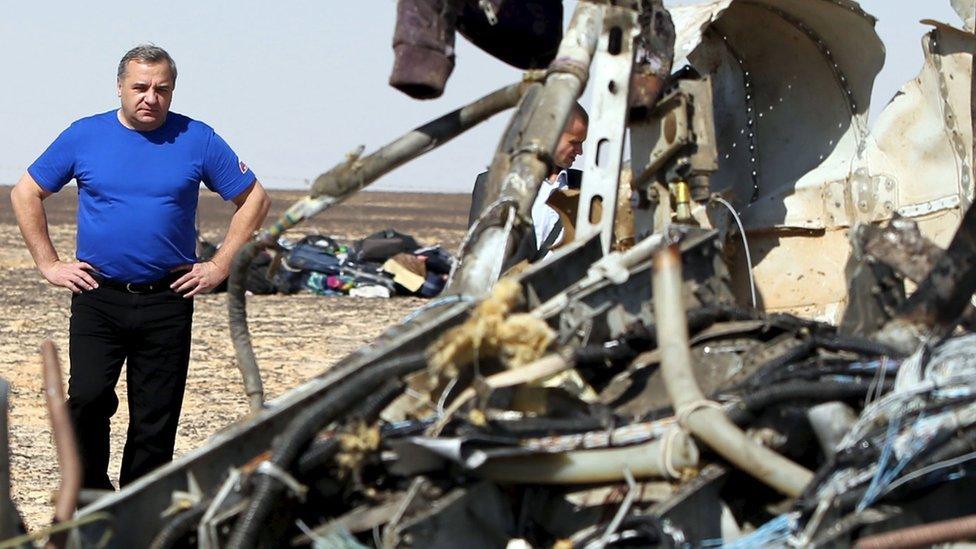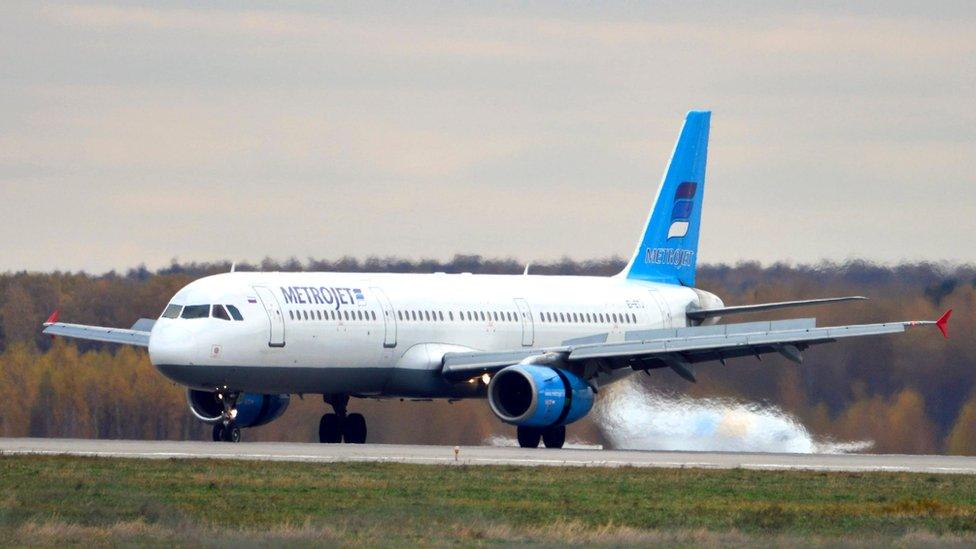Russian plane crash: What we know
- Published

Egyptian Prime Minister Sherif Ismail (foreground) visited the crash site
What we know about a Russian passenger plane that was brought down by a bomb in Egypt's Sinai peninsula on 31 October, killing all 224 people on board.

What happened?

The Airbus A321, operated by the Russian airline Kogalymavia, took off from Sharm el-Sheikh airport at 05:58 (03:58 GMT), external on 31 October.
At 06:14 Egyptian time (04:14 GMT), the plane failed to make scheduled contact with air traffic control based in Larnaca, Cyprus.
The plane disappeared from radar screens six minutes later while flying over central Sinai. Egyptian authorities said no SOS calls were received by air traffic controllers.

Russia's Interfax news agency cited a source in Cairo as saying, external "uncharacteristic" sounds were picked up by the cockpit voice recorder before the plane disappeared from radar screens. "The recordings suggest that an emergency situation occurred on board unexpectedly and took the crew by surprise," the source said.
Data released by the flight tracking website Flightradar24, external showed that just before the radar signal was lost, the aircraft reached an altitude of more than 33,000ft (10,060m), then started to descend with a vertical speed of about 6,000ft a minute. The plane's forward speed meanwhile dropped to around 170km/h (105mph), slower than the speed necessary to continue safe flight.

Egyptian military aircraft subsequently located the wreckage of the plane in the Hasana area, 95km (59 miles) south of the Mediterranean coastal town of el-Arish.
Russian officials said the wreckage was scattered across a 20 sq km (7.7-sq mile) area, meaning that the plane broke up in mid-air before falling to earth.

What caused the crash?

Russia said on 17 November that a "terror act" was responsible for the crash and that "traces of foreign explosives" were found on debris of the Airbus.
UK security service investigators say they suspect someone with access to the aircraft's baggage compartment inserted an explosive device inside or on top of the luggage just before the plane took off.
A US official told, external AP on 4 November that US intelligence agencies also had preliminary evidence that suggested a bomb planted by the local affiliate of the jihadist group Islamic State (IS) brought down the plane.
Militants from that affiliate, known as Sinai Province, said they brought down the plane shortly after it crashed, with a spokesman claiming this was "in response to Russian air strikes that killed hundreds of Muslims on Syrian land". But he did not provide evidence, asserting: "We are not obliged to disclose the mechanism of its demise."
Egyptian officials have said it is too early to draw conclusions on the cause. Both of the plane's "black boxes" have been recovered as part of the investigation.

Who is leading the investigation?

Russia's Emergencies Minister Vladimir Puchkov is one of those to have visited the crash site
Egypt is leading the investigation, with the help of Russian and other international experts.
Air accident investigators from France - home of Airbus, which manufactured the plane - are also involved.
As the plane was registered in Ireland - the home of the company that leased the aircraft to Kogalymavia - a team of Irish investigators have also travelled to Egypt.
German experts are also involved because the plane was assembled in Germany in 1997, and its flight recorders were made there.

Who are the victims?

Relatives and friends of those on board gathered at St Petersburg's Pulkovo airport
The plane was carrying 224 people in total, external, including 219 Russian citizens, four Ukrainians and one Belarus national. Of the 217 passengers, 17 were children. Most of the passengers were tourists.
Many of the victims were members of the same families. A large number of them shared the same last name, and it appears that in some cases three generations of the same family perished in what is believed to be the worst air disaster involving a Russian plane.

What do we know about the plane?
The twin-engine A321 has a range of up to 7,400km (4,000 nautical miles). It can accommodate up to 220 passengers.
The plane which crashed was 18 years old, making it one of the oldest A321s in service. It had flown for 56,000 hours over nearly 21,000 flights, according to Airbus.
It was produced in May 1997 and delivered to the Lebanese carrier Middle East Airlines. It changed hands eight times, external before being leased in 2012 to Kogalymavia, an airline based in western Siberia that also operates under the name Metrojet.

The plane was on its way to St Petersburg when it crashed
The plane was registered in Ireland and leased to Kogalymavia by Willmington Trust SP Services (Dublin) Ltd. According to the Irish Aviation Authority (IAA), it passed an annual airworthiness certificate in March 2015.
However, the plane had been damaged in 2001, when it was operated by Middle East Airlines, suffering a tail strike on a Cairo runway.
Kogalymavia has said that the damage was fully repaired and would not have affected the plane.
The plane's engines had also been checked on 26 October, Kogalymavia said, and it underwent a major maintenance inspection and overhaul in Turkey in March 2014.
The A321 has a generally good safety record. According to a study, external by aircraft manufacturer Boeing of crashes between 1959 and 2014, there were 22 incidents in which a plane from the A321 family was damaged beyond repair - known in the industry as a "hull loss".